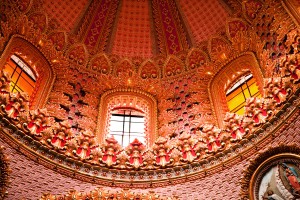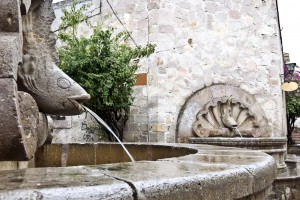I’m pretty sure the Spaniards that built the colonial city of Morelia, Mexico, were confectioners at heart. They just had to be: over 200 buildings in this charming historic center are built using pink stone and decorated with so many of arches, spires and domes that they bring to mind a very large, very stylish (if that’s possible) quinceañera cake.
A walk down the centro’s streets, laid out in perfect Colonial-era grids, is a treat in itself. They’re clean and tidy, and the cake–like buildings that line them hide all manner of restaurants, shops and an astonishing amount of dulcerías, or candy stores. In fact, Morelia is the “Candy Capital of Mexico”, which, in a country with an acutely overdeveloped sweet tooth, is quite an honor.
Mexican candies are overall gooier, chewier, sweeter and much more imaginative than anything you’d find at your local US candy shop—barring, of course, the Willie Wonka factory. Candies here tend to be quite hefty and the traditional ones are made with no artificial flavors or preservatives.
My first stop is the Mercado de Dulces (Candy Market) on Avenida Madero Poniente at Valentín Gómez Farías, behind the imposing Palacio Clavijero. The local bees seem to have beaten me to it: the Mercado is literally a-buzz. After a quick inquiry, I’m assured I don’t have anything to fear unless I’m a cluster of candied coconut. No worries there.
I duck inside the hallways tucked under the arches behind what was once a Jesuit college (just about everything here has a pedigree) and I’m greeted by a riot of sights and smells. Candies of all sorts are perilously stacked in brilliant pyramids, artfully arranged in wicker baskets or hanging in little plastic bags from every conceivable surface. It’s a controlled chaos of color and sound, and while the bees seem to be everywhere, they’re way too busy to bother with humans.
The tightly packed stalls offer literally hundreds of different candies from all over Mexico. I notice most of them feature trays of ate (ah-tay), one of Morelia’s most popular candies. Created in the days before refrigeration as a means of preserving local fruits, ate is a kind of jellied paste originally made from quince. Today, ate is also made from guava, mango and other local fruits.
Disc-shaped morelianas are another of the city’s trademark sweets: two thin wafers spread with the ubiquitous cajeta, or goat-milk caramel. Mari, one of the vendors, shows me how to test the freshness of a moreliana: bend it slightly and if it gives it’s good; if it breaks, it’s old. She tells me her family has been making and selling candy for generations; I wonder about the family’s dental bills, but fortunately the cajeta keeps my mouth busy.
Looking over the mounds of ates, cocadas, jamoncillos, tarugos, paletas, borrachitos and more (see sidebar), I spy what looked to be row upon row of bottles filled with yellow eggnog. Called rompope, this sweet concoction was originally created by the nuns in a convent in Puebla. (My Mom adds a splash to her cappuccino, so I ask for a bottle with a picture of Santa Clara on it.)
I resolve to stop tasting candy by the fifth stall to avoid sugar shock and begin stockpiling treats in my mesh bolsa del mandado. Fortunately, the candy market doubles as a mercado de artesanías, or craft market, and my attention is soon drawn by beautiful handmade toys and handicrafts—perfect for souvenirs. Each of the towns surrounding Morelia is known for its handicrafts, including Santa Clara del Cobre’s copper, Tzintzuntzan’s burnished pottery, Pátzcuaro’s rich textiles and much more.
The traditional candies on display in the mercado piqued my interest in history, and I was duly directed to the Museo del Dulce, a candy museum on Calle Madero owned by one of the oldest candy-making families of Morelia. Stepping over the threshold is literally stepping back in time: even the smiling attendants are dressed in turn-of-the-century outfits from the era of the Porfiriato, a period of Mexican history marked by prosperity and peace.
The aroma of melting sugar fills the air as I walk around the Museo. Part retail shop, part museum and part candy factory, it’s the showcase for the De la Calle Real candy-making company and a living testimony to a passion for Morelia’s sweetest traditions. I decide to take the tour, and after paying a nominal fee, a slender attendant in a plumed hat shows me to the gallery near the Bartolomé de las Casas entrance. Period photographs of women in enormous skirts and men with lush mustaches gaze at me benevolently while the guide introduces them and offers a bit of history.
The portrait wall was followed by a well-made ten-minute movie (with subtitles) on the origins of candy-making in Mexico and in Morelia, and then it’s on to view the machinery used in the early days, followed by an actual demonstration in the Colonial kitchen. There, another costumed attendant fired up a copper kettle, stirring in equal parts guava pulp and cane sugar. The tart unmistakable scent of guayaba filled the air as she mixed the blend with a wooden paddle, and in seven minutes the newly formed ate was ready to be poured into the waiting molds.
After the presentation, I was led out through the Museo’s café—aptly named Café del Patio de Atrás (Back Patio Café). I settled in and was served a rich, aromatic semi amargo (dark) chocolate with a slice of pastel de elote (slightly sweetened corn cake), one of over 30 varieties they bake daily.
As I backed my chair away from the table my leg brushed up against my bolsa del mandado, now brimming with gaily wrapped treats from the Museo. Happy with the prospect of savoring Morelia long after I returned home, I picked up my bag and headed back to my hotel, hoping the walk would burn off at least part of the calories I had accumulated on my sweet quest…










